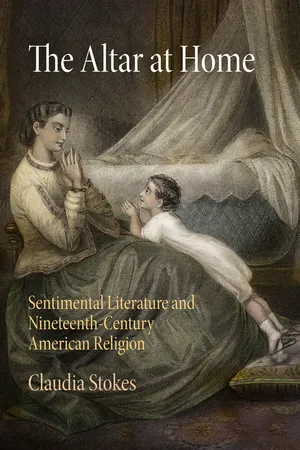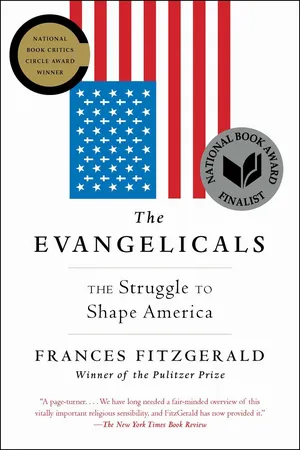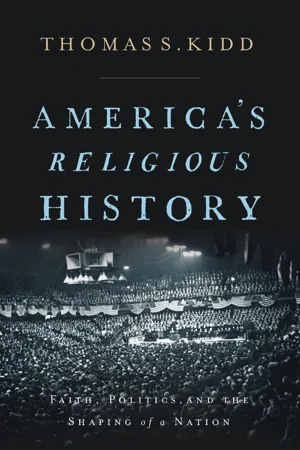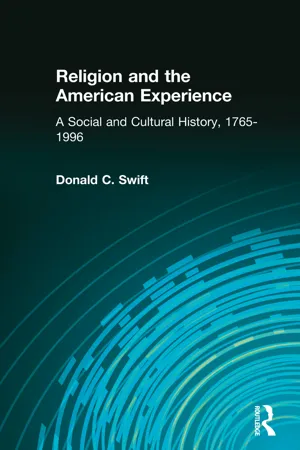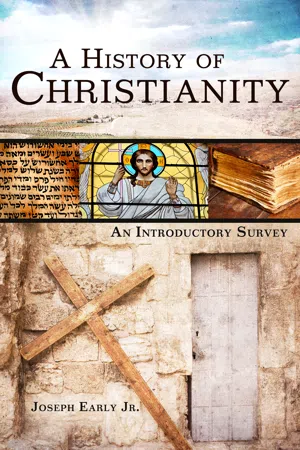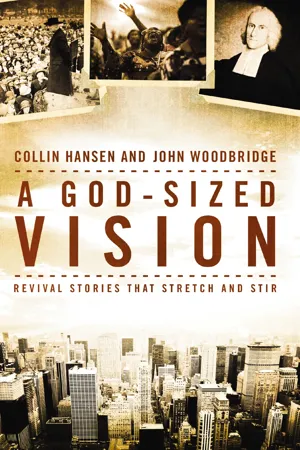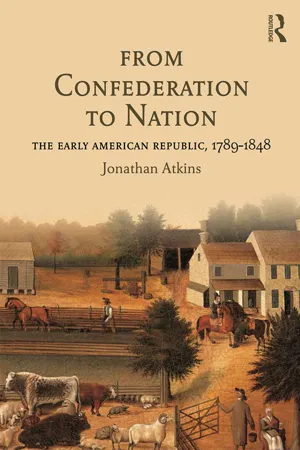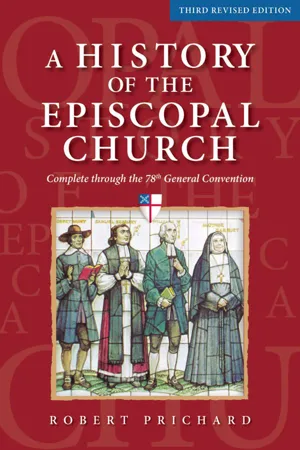History
Second Great Awakening
The Second Great Awakening was a religious revival movement in the United States during the early 19th century. It emphasized individual salvation, emotional preaching, and a focus on personal piety and morality. The movement had a significant impact on American society, contributing to the rise of various reform movements, including abolitionism and women's rights.
Written by Perlego with AI-assistance
Related key terms
Related key terms
1 of 4
Related key terms
1 of 3
10 Key excerpts on "Second Great Awakening"
- eBook - ePub
The Altar at Home
Sentimental Literature and Nineteenth-Century American Religion
- Claudia Stokes(Author)
- 2014(Publication Date)
- University of Pennsylvania Press(Publisher)
Though the Second Great Awakening and its doctrines may seem emancipatory because of their promotion of religious liberty, that liberty was constituted along sectarian lines, for it was used to justify the public condemnation of religious groups deemed repressive and at odds with religious autonomy. Indeed, Calvinism itself was often the subject of sentimental denunciation because its doctrines and clericalism were presumed to stand in violation of the religious liberty at the heart of sentimental piety. However, the principal target in the era’s promotion of religious liberty was without question Catholicism, and, by promulgating teachings that announced their commitment to religious autonomy, sentimental literary texts actively contributed to anti-Catholic discourse and suspicion. Participation in sectarian divisiveness was not an accidental consequence of the sentimental foundation in the Second Great Awakening. Rather, it was strategic and opportunistic, for it was at the expense of these maligned denominations that sentimental women writers and texts were able to execute and justify the authority they pursued. In simultaneously championing emancipatory new doctrines and dissuading readers from these authoritarian sects, sentimental writers appointed themselves the protectors of the reader’s own religious authority, a task that by extension allowed them to claim that authority for themselves.Contexts of the AwakeningThough the Second Great Awakening may seem an unlikely ally of sentimentalism, this period of a half century, from roughly 1790 to 1840, produced the cultural climate necessary for the development of this literary movement. Where the first Great Awakening of the 1740s was firmly rooted in New England orthodoxy, the Second Great Awakening was diffuse, denominationally heterogeneous, and geographically expansive, encompassing both East Coast cities and rural frontier regions alike. The Second Great Awakening was a period of immense theological innovation and creativity, giving rise to a dramatic spike in religious fervor and the formation of innumerable new denominations and sects, such as the Campbellites, the Church of Jesus Christ of Latter-day Saints, the Millerite Adventists, and the Oneida Perfectionists. According to William McLoughlin, the Second Great Awakening can be understood as the religious extension of the new political sovereignty afforded by the American Revolution, for the period was characterized both by the active pursuit of personal religious independence and an overt antipathy for governing clerical authority.7 The changing denominational landscape of the period offers ample evidence of this shift, as with the declining fortunes of Calvinist orthodoxy. In the aftermath of the American Revolution, the orthodox belief in predestination became irreconcilable with the era’s preoccupation with liberty and self-determination, and the inexplicable salvation of the elect disconcertingly evoked an aristocratic caste whose superior status was the product of the felicitous accidents of birth rather than merit. The rolls of orthodox Calvinist denominations consequently plummeted, the membership of the Congregationalists alone falling from 20 percent of American church members in 1776 to 4 percent in 1850.8 Public attitudes toward Catholicism in this era also register the influence of post-revolutionary anxieties about the incompatibility of older religious movements with new American independence and the suspicion that such sects might reinstate authoritarian rule. Amid escalating immigration of European Catholics as well as growing numbers of conversions to Catholicism, Protestant critics across denominations denounced Catholicism as inherently incompatible with American democracy, for it demanded unquestioning submission to unelected clergy as well as to the European regime of the pope himself. Critics publicly decried Catholic immigrants to the United States as the pawns of a conspiratorial plot between European monarchies and the papacy to overturn American democracy, and much of the evangelical fervor of the Second Great Awakening derived from a pan-Protestant campaign to arrest the spread of Catholic influence by inciting widespread Protestant conversion, as with the anti-Catholic mission of such vital evangelical organizations as the American Home Missionary Society and American Tract Society.9 - eBook - ePub
The Evangelicals
The Struggle to Shape America
- Frances FitzGerald(Author)
- 2017(Publication Date)
- Simon & Schuster(Publisher)
1
THE GREAT AWAKENINGS and the EVANGELICAL EMPIRE
T HE ORIGINS of evangelicalism as a distinct form of Protestantism lie in the revivals that swept back and forth across the English-speaking world and Northern Europe in the eighteenth and nineteenth centuries. In the American case, the revivals came in two waves. The earlier, known as the First Great Awakening, peaked in the 1740s but set off reverberations that continued to the time of the American Revolution. The later one, the Second Great Awakening, began just after the end of the War of Independence and continued intermittently in various parts of the country through the 1850s. Everywhere, the revivals involved a rebellion against the formalism of the established churches and an effort to recover an authentic spiritual experience: a religion of the heart, as opposed to the head. And everywhere, they introduced a new idea of conversion as a sudden, overwhelming experience of God’s grace. In Europe the established churches survived and incorporated the pietistic strain within their own traditions. But in America the revivals transformed Protestantism. They undermined the established churches, led to the separation of church and state, and created a marketplace of religious ideas in which new sects and denominations flourished. At the same time, they made evangelical Protestantism the dominant religious force in the country for most of the nineteenth century.In America the periods were, not incidentally, ones of rapid demographic growth, and social, as well as political, change. The expansion of settlement and commerce opened space for initiative and innovation, and small, integrated communities dissolved into an expansive, mobile society. The itinerant revivalists themselves embodied this mobility and this reach. In offering individuals the possibility of a direct relationship with God they helped adjust the society to its new circumstances and to transform the hierarchical colonial order into the more egalitarian society of the nineteenth century. After the Revolution many of them explicitly preached individual freedom, the separation of church and state, voluntary association as a primary means of social organization, and republicanism as the best form of government. Awakenings, as the scholar William McLoughlin tells us, “are periods of cultural revitalization . . . that extend over a period of a generation or so, during which time a profound reorientation of beliefs and values takes place.”1 - eBook - ePub
America's Religious History
Faith, Politics, and the Shaping of a Nation
- Thomas S. Kidd(Author)
- 2019(Publication Date)
- Zondervan Academic(Publisher)
Chapter 4THE ERA OF THE SECOND GREAT AWAKENINGBy the year 1800, American Christianity, in tandem with the nation’s population, entered a new phase of westward growth and organization. The nation’s progress into the West displaced many Native Americans and precipitated the monumental Louisiana Purchase of 1803, by which the United States roughly doubled in size. Even before the Louisiana Purchase, white settlers surged into the Ohio River Valley region and the Deep South. By the 1840s, westward settlement spread out to California and the Oregon Territory, with people seeking gold and more farmland. Churches and itinerant pastors kept up with and even surpassed the pace of settlement, and they sometimes sought to address the plight of displaced Native Americans. Led by the Methodists and Baptists, churches socially organized the West on the ground level.The Second Great Awakening was punctuated by massive revivals. These included its seminal event, the Cane Ridge Revival in Kentucky in 1801. Revivals often resulted in significant seasons of church growth. More than a series of revivals, the Second Great Awakening was also a process by which millions of Americans came into the fold of Christiancongregations. Sometimes attending a revival was a critical part of the process for those who became devout church members. Just as important over the long term were the quieter labors of hard-working ministers who spread through the Midwest, Southwest, and ultimately the Far West. Town by town, family by family, they gave frontier people a message of gospel hope. They also provided them with a local church, which often represented the only regular social outlet that frontier families had.Countless preachers and Christian laypeople participated in the frontier expansion of Christianity. For example, Joseph Willis was a former slave turned Baptist pastor, who may have delivered the first Protestant (or at least Baptist) sermon west of the Mississippi River. Willis received his freedom in 1787, the year of the Constitutional Convention in Philadelphia. Willis went from South Carolina into the Mississippi Territory and then into Louisiana. Napoleon Bonaparte of France acquired the vast Louisiana Territory, which included the future state of Louisiana, from Spain in 1800. Willis arrived in Louisiana around the time that President Jefferson arranged to procure the territory from France. - eBook - ePub
Religion and the American Experience: A Social and Cultural History, 1765-1996
A Social and Cultural History, 1765-1996
- Donald C. Swift(Author)
- 2016(Publication Date)
- Routledge(Publisher)
In New England, another central focus of revivalist activities was the enlistment of people in a crusade to arrest the decline of the influence of organized religion and to create a Christian America. While many New England Calvinist clergy hoped revivalism would restore what they saw as eroding status and authority, clergymen wanted the full measure of power and standing enjoyed by their predecessors. Laymen who had been exhorted to take leading roles in voluntary benevolence were not as likely to dutifully await clerical guidance or view clergymen as intermediaries between God and men. Lyman Beecher, a Dwight student, was to become a leader of revivalistic activities in New England and the West. He was an unusually capable organizer, skillful at spreading the evangelical message through the printed word. In time, Beecher and others would successfully redirect evangelical efforts toward upholding the new economic order and removing "antimammon" elements from New Divinity theology.In the South, both blacks and whites attended revivals in large numbers; frequently whites were outnumbered by blacks at these gatherings. Here and there mostly white congregations acquired spellbinding African American preachers. Egalitarianism and populism would characterize the early decades of the Second Great Awakening in the South and West.The Second Awakening
Christianity's role in American life expanded greatly in the nineteenth century as evangelism came to dominate American Protestantism. For many, it was a means of revitalizing their belief systems, which seemed threatened by deism, western infidelity, economic development, and democratic challenge to established institutions. The Second Great Awakening, spanning the first half of the century, brought mass evangelism to almost every part of the nation. (Some have placed the Awakening in the years 1780-1830).This great outburst of evangelical revivalism marked the democratization of American Protestantism. People rejected formal doctrines and selected their own religious spokesmen, who frequently lacked theological education, or even formal education beyond elementary school. Although Mormons and Methodists had hierarchies, the thrust of the revivalistic activities was democratic because the revivalists condemned social distinctions. All believers were encouraged to give testimony regarding their religious experiences. Spiritual ecstasy or the "enthusiasm" that the Puritans had so detested now became respectable. Traditional hymns often gave way to spirited songs that resembled African American spirituals. Not only the songs but the manner in which they were sung, and the emotions they unleashed, reflected the profound influence of African American spirituality on the Second Great Awakening. The impact of African American spirituality was particularly strong among early Methodists; the level of religious enthusiasm would later decline as Methodists acquired greater social status. Camp meetings could be seen as "festivals of democracy." Clergy were no longer viewed as mediators between God and man, and the impression was given that the revivalists had restored the Bible as the basis for belief. The primacy of the individual conscience was emphasized, and revivalists preached that holiness was reserved for the poor and humble in spirit rather than the proud and rich. - eBook - ePub
A History of Christianity
An Introductory Survey
- Joseph Early(Author)
- 2015(Publication Date)
- B&H Academic(Publisher)
Chapter Twenty-FiveThe Second Great Awakening and Its After-EffectsT he Second Great Awakening (1790–1830) had three distinct but interrelated phases. The first occurred at Yale College and affected New England Congregationalism. The second, on the western frontier of Kentucky, Missouri, and Tennessee, was noted for its intense revivals. The third was dominated by Charles Finney’s ministry and revivals.Yale and the New England PhasePresident Timothy Dwight of Yale College (1752–1817), the grandson of Jonathan Edwards, is credited with starting the Congregational phase of the Second Great Awakening. Dwight feared that Yale students were more interested in Deism than Christianity. So along with other professors, he began lecturing and preaching on the truths of Christianity. A revival began in 1802. When it ended, more than seventy of the 225 students at Yale had been converted. The Yale revival then spread to other colleges throughout the United States.1 As Dwight hoped, the revival helped stop the spread of Deism at Yale and in the United States.Nathaniel Taylor (1786–1858), a student at Yale during the revivals, set forth what came to be known as “Taylorism” or “New Haven Theology.” He spoke against the rigid predestination of old-school Calvinism, believing the revivals demonstrated that human freedom played a role in conversion. Everyone was a sinner, but Adam’s sin was not imputed to others, he said. Each human was responsible only for his own sin, and man had the ability to choose whether or not to sin. In 1822 Taylor was named professor of didactic theology at the newly established Yale Divinity School. The father of author Harriet Beecher Stowe (1811–1896), Lyman Beecher (1775–1863) was the most influential proponent for of New Haven theology.While still Calvinistic, New Haven theology represented a step toward Arminianism and continued America’s drift from the theology of its first Puritan settlers. By amending the traditional Calvinist doctrines of original sin and imputation,2 - Zondervan, Benjamin K. Forrest, Kevin King Sr., Dwayne Milioni, William J. Curtis(Authors)
- 2018(Publication Date)
- Zondervan Academic(Publisher)
1 He later related that his family was never significantly religious, though they did periodically attend local Presbyterian and Baptist churches. Finney grew up in the formative decades of the new nation where democratic, populist, and experimental impulses were prevalent. These features molded America’s religious landscape, which fueled the growth of popular denominations (Methodist and Baptist), the emergence of new movements such as restorationism, and the appearance of new religions altogether, like Mormonism. American revivals also felt these shifts. The Second Great Awakening (1790–1835), which was well underway during Finney’s youth, was, on the whole, more experientially intense, less theologically exact, and less Calvinistic when compared with the First Great Awakening. In short, American religious life was undergoing a dramatic transformation throughout Finney’s youth.Theologically, the most important background to Finney’s ministry was the New England Theology promoted by the Congregationalists of the northeast.2 New England Theology was a unique school of Calvinism which originated in the writings of Jonathan Edwards (1703–1758) before it was repackaged by his disciples Joseph Bellamy and Samuel Hopkins.3 It gained a sizable following in both Congregational and Presbyterian pulpits throughout the northeast by the turn of the nineteenth century and was a primary factor in the New England phase of the Second Great Awakening.4 New England Theology was an intensely theological and revivalistic version of Calvinism that heralded two seemingly contradictory lines of thought. First, it maintained central features of traditional Calvinist preaching, such as the sovereignty of God in salvation and the fact of human moral inability (human beings reject Christ because they lack the moral inclination to choose him as their greatest happiness). Second, it underscored God’s benevolent regard to all of creation (God is lovingly disposed to the entire system of being) as well as a human being’s natural ability to comply with the terms of the gospel (individuals theoretically could choose Christ because there is no defect in their createdness; they can choose Christ if only they would do so).5- eBook - ePub
- Collin Hansen, John D. Woodbridge(Authors)
- 2010(Publication Date)
- Zondervan(Publisher)
CHAPTER 2 “SURPRISING” SIGNS OF THE NEW BIRTH First Great Awakening, 1730s to 1740s N ORTH A MERICA While colonial America may seem to be a model of religious virtue, Christianity rode the ups and downs of life on an exciting, dangerous frontier. Following the devastating King Philip’s War in 1676, in which half of the English settlements in Massachusetts and Connecticut were destroyed, pastors urged Christians to renew their commitments to God and one another. Nevertheless, rock-ribbed New England, home to the descendants of Puritans who risked everything to settle in a strange new world, suffered from an identity crisis. The emotional exhortations of past Puritan preaching had given way in many quarters to rational lectures that prized reason over affections, the mind over the heart. Still, small pockets of piety stood out. Under the leadership of Solomon Stoddard, the congregation at Northampton in western Massachusetts experienced five fleeting revivals between 1679 and 1718. A bigger revival touched Connecticut between 1720 and 1722. Hundreds of new Christians joined churches. Then in 1727, a shocking earthquake shook up Northampton and the rest of New England. Always searching for evidence of God’s plan, New England’s leading pastors warned their congregations to repent, because God might shake the earth once more with a special movement of the Holy Spirit. This emphasis on “seasons of revival” marked a “new elaboration” of the Protestant Reformation, according to historian Thomas Kidd. 1 During what would come to be known as the First Great Awakening, a diverse group of Protestant movements, ranging from Continental Pietism, Scots-Irish Presbyterianism, and Anglo-American Puritanism, would cooperate and swap ideas on how to promote and sustain revivals. Several leaders would emerge and leave behind a lasting legacy - eBook - ePub
From Confederation to Nation
The Early American Republic, 1789-1848
- Jonathan Atkins(Author)
- 2016(Publication Date)
- Routledge(Publisher)
Connecticut would disestablish its church seventeen years later, and for later generations Jefferson’s “wall of separation” metaphor became a core principle in constitutional thought. But to Jefferson’s dismay—and the Baptists’ delight—religious freedom took the Union in a different direction than the third president expected. The enlightened rationalism that the third president thought would prevail in the Union instead lost adherents. Conversely, religious revivals swept across the states, convincing thousands that God had chosen America to be His “New Israel.” Faith underlay a strong conviction that moral reform could purify their society, as believers joined with skeptics to promote the improvement of individuals and institutions. For millions, self-control provided the key to a successful and well-meaning life; for some, withdrawing to form a perfect society offered the solution. Like economic and social change, revivalism and reform fostered the belief that Americans belonged to a national community that transcended loyalties to the states. They also highlighted the tensions over slavery that threatened national unity. Whether dedicating themselves to God, to righting social wrongs, or to creating their world anew, revivals and reform movements offered Americans a way of restoring a sense of order in a nation that, to many, seemed to be changing too fast.The Second Great Awakening
Jefferson, the Danbury Baptists, and virtually every white American grew up in a culture heavily influenced by the Judeo-Christian tradition. Protestant versions of Christianity dominated the European nations from which their colonial ancestors had come, so most Americans accepted the existence of a God who controlled nature and human affairs and expressed Himself in the Trinity—that is, as a Heavenly Father; as Jesus the Son, who had lived among men and through His death reconciled followers to the Father; and as the Holy Spirit, which represented the continuing presence of God on Earth. Most accepted Christianity’s basic moral and ethical teachings as well as the Bible as God’s word. The English colonies had supported religion’s influence in society through public prayers and public proclamations declaring days of fasting or thanksgiving. Most colonies had also provided financial and legal support for an officially established church. The Church of England, or Anglican Church, had enjoyed government backing in New York and the colonies south of Pennsylvania, while New England’s Puritan origins had made the Congregational Church the established faith in Massachusetts, New Hampshire, and Connecticut. Only Rhode Island, Pennsylvania, Delaware, and New Jersey had officially allowed religious freedom, though these colonies still required belief in God. - eBook - ePub
- Michael Pasquier(Author)
- 2016(Publication Date)
- Routledge(Publisher)
A fifth Protestant denomination – Methodism – surged into the American spotlight following the revolution. In 1784, with authorization from the Anglican priest John Wesley in England, a small group of clergymen met in Baltimore, Maryland, to form the Methodist Episcopal Church. Francis Asbury (1745–1816), born in England and son of a gardener, became one of the first two bishops of the new denomination. Known as an authoritarian, Asbury assigned clergymen to “circuits,” or geographic areas, that extended deep into the American frontier. “Circuit riders,” as they were called, avoided isolating their ministries to a single church or congregation, choosing instead to travel from town to town and homestead to homestead preaching the Methodist message of holiness and sanctification. By 1820, the number of Methodists surpassed even that of Baptists, making the Methodist Episcopal Church the largest denomination in the United States.Although hardly a unified revival movement, the Second Great Awakening represented a general resurgence of evangelical Protestant commitments to biblical authority, emotional conversion, and missionary fervor. Its influence surged at different times and in different places throughout the first three decades of the nineteenth century. And its reach included white and black, male and female, rich and poor, and urban and rural residents of the United States. The Second Great Awakening can be broken into three general phases.New England was the site of the first phase. Congregationalist clergymen, especially those in Connecticut, channeled Jonathan Edward’s New Light alliance of Calvinism and revivalism to communities throughout the region. Yale College, with the support of its president Timothy Dwight (1752–1817), became the epicenter of this new revivalism. Dwight was an advocate of immediate conversion who believed that humans played an active role in accepting or rejecting salvation. Among the hundreds of students affected by Dwight’s preaching, Lyman Beecher (1775–1863) stood out. Ordained a Presbyterian minister in 1799, Beecher championed Protestant voluntarism (the voluntary basis of church membership and theological adherence) and supported organizations devoted to social reforms like temperance and abolitionism. He also railed against the perceived threat of the Catholic Church to religious freedom. With Protestant unity as one of his chief goals, Beecher preached the millennialist message that “the providence of God is calling upon Christians of every denomination, to cease from their limited views, and selfish ends, and to unite in the conflict which is to achieve the subjugation of the world to Christ.” - Robert W. Prichard(Author)
- 2014(Publication Date)
- Morehouse Publishing(Publisher)
48The Effects of the AwakeningThe Great Awakening changed the theological character of the colonial Church of England. While advocates of awakening of the 1760s and 1770s never did abandon episcopal succession or the fixed liturgy in the way that Whitefield had been willing to do in 1739, they did adopt sentimentalist styles of preaching and Whitefield’s call for adult conversion. Even critics of the Awakening began to pay greater attention to personal religious experience. The attempt to integrate this new appreciation for affections with the received covenant tradition would, in turn, be a major topic of interest for theologians at the end of the century.Changes were not only theological, however. Indeed, there were few aspects of church life that were left untouched. The membership, the institutions, and even the architecture and church music of the denomination were affected.The MembershipOne way in which the Great Awakening changed the membership was by subtly raising the status of women. Female literacy was considerably lower than male literacy in the eighteenth century; by some estimates it was one-half that of men.49 The intellectual religion of the Moderate Enlightenment had, therefore, limited appeal to women. The Awakening, however, with its emphasis on affections and its household prayer meetings, provided new opportunities for female involvement. Martha Laurens Ramsay (1759–1811), the daughter of a prominent South Carolina family that attended St. Philip’s Church in Charleston, found, for example, that her awakened faith opened doors to a world with greater possibilities. She corresponded with such pious Englishwomen as Selina, Countess of Huntingdon (1707–91) and began a personal religious journal, which was published by her husband after her death.50
Index pages curate the most relevant extracts from our library of academic textbooks. They’ve been created using an in-house natural language model (NLM), each adding context and meaning to key research topics.
Explore more topic indexes
Explore more topic indexes
1 of 6
Explore more topic indexes
1 of 4
